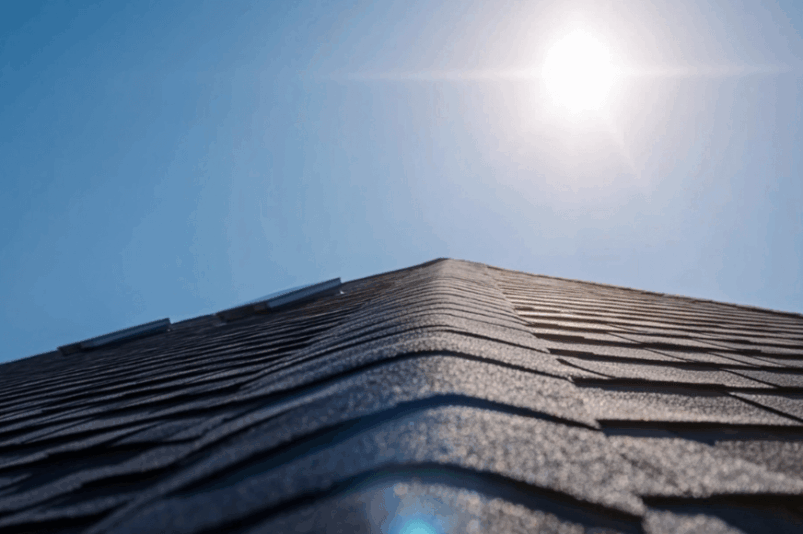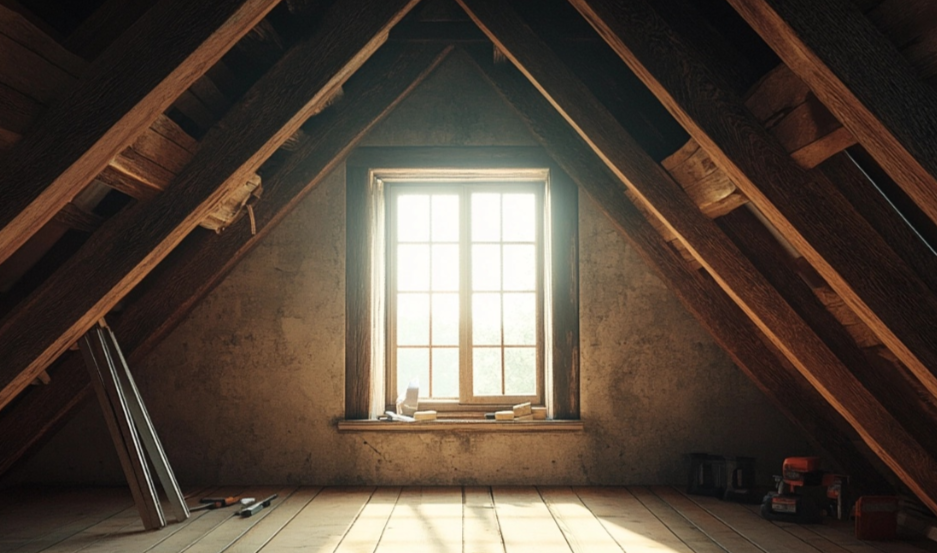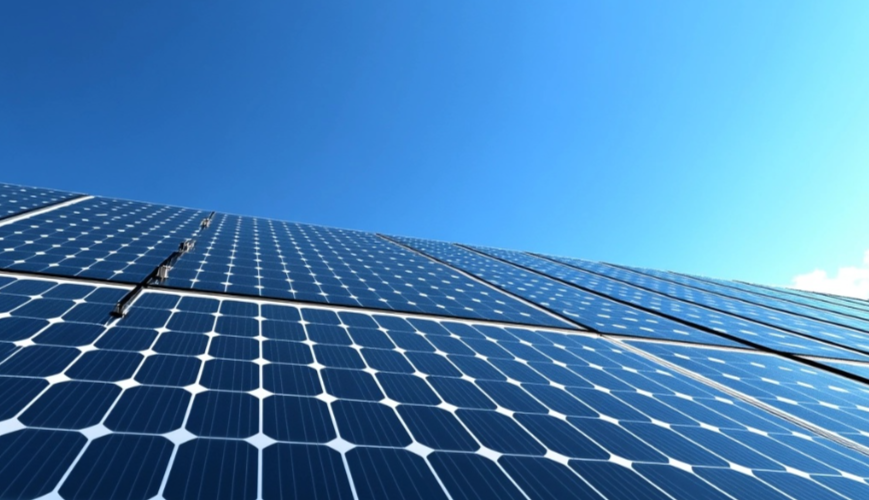
If you live in Texas, your roof isn’t just a roof, it’s the first line of defense against triple-digit summers that feel like they’re trying to cook you alive. While blasting the A/C might be your go-to move, your roof could either be fighting the heat…or quietly working against you.
That’s where smart roof cooling techniques come in.
Most online advice stops at “paint it white” or “add more insulation.” Not here. I’ve included some underrated strategies that can actually make a measurable difference in how hot your home gets during peak summer. Whether you’ve got a metal roof baking in San Antonio sun, or a shingle roof in the middle of a DFW heatwave, these cooling tricks are built for real Texas homes and real Texas heat.
1. Roof Pitch Affects Heat Absorption
Most people focus on materials or coatings, but your roof’s angle plays a big role in how much heat it soaks up. A low-slope or flat roof in Texas is basically sunbathing all day. Steep-pitched roofs, on the other hand, catch less direct sunlight during certain times, especially in late afternoon when heat peaks.
If you’re re-roofing or building new, it’s worth considering how pitch affects solar exposure. For flat roofs, reflective coatings and insulation become even more critical. For steeper roofs, you may be able to rely more on strategic ventilation and color choices to manage heat gain.
Key takeaway: steeper isn’t always better, but it does change your strategy.
2. Radiant Barriers: Your Attic’s Hidden Shield

Radiant barriers are one of the best-kept secrets in roof cooling. Unlike traditional insulation, which slows heat transfer, radiant barriers reflect heat before it ever enters your living space. In Texas attics, this can drop temperatures by up to 30 degrees. No joke.
They’re usually installed under the roof decking or stapled to the underside of rafters. Combined with good ventilation, they help your attic stay much cooler, which reduces strain on your HVAC and lowers energy bills. They’re cheap, easy to install, and extremely effective in sunny states like Texas.
If your roofer doesn’t bring it up, you should.
3. Misting Systems for Roofs
You’ve seen misting systems on patios, but some homeowners are using them on rooftops too. The concept is simple: a fine mist of water sprayed across your roof evaporates quickly, pulling heat away with it. It’s the same principle that cools your skin when you sweat, just scaled up.
I’ll be honest, this isn’t a mainstream solution yet, and it’s definitely more common in dry climates where evaporation works fast. That said, in parts of Texas where humidity stays relatively low, it can be a surprisingly effective add-on, especially for metal or tile roofs. Just make sure your setup is built to handle the mineral content in your water supply, or you’ll end up with deposits instead of relief.
4. Cool Coatings vs. Reflective Shingles: What Works Better in Texas?
I’ve seen these recommendations quite a bit online, but almost none tell you which is actually better. Here’s the breakdown.
Cool coatings are ideal if you’re working with an existing roof you don’t want to fully replace. These elastomeric or silicone coatings add a UV-reflective top layer that can drop surface temps by 20 to 50 degrees.
Reflective shingles, on the other hand, are a long-term play. They’re designed to look like traditional shingles but reflect far more sunlight. The catch is that they only work well if your roof is already in good condition, and not every brand performs equally in high heat.
If your roof’s in solid shape and you plan to stay put, reflective shingles are worth the investment. If you just need relief now, a cool coating is faster and cheaper.
5. DIY Cooling Possibilities
Yes, and plenty of Texans do it. While radiant barriers go on the attic side of your roof deck, there are other DIY-friendly ways to insulate from the inside. This is common in older homes where ripping up shingles isn’t an option.
Foil-faced foam board insulation, spray foam, and even bubble wrap-style radiant foil rolls can all help block radiant heat from getting into your living space. These aren’t permanent fixes, but they’re fast, relatively cheap, and surprisingly effective when combined with good attic ventilation.
If your budget’s tight or your HOA is strict about exterior changes, inside-out cooling might be the best move.
6. Solar Panels as Shade, Dual Benefit!

Most people think of solar panels for electricity, but in Texas, they double as roof shade. A solar array blocks direct sunlight from hitting your roof surface, lowering attic temps while producing energy at the same time.
This is especially helpful on dark shingle or tile roofs, which tend to trap more heat. Panels create an air gap between themselves and the roof, and that space helps dissipate heat before it gets absorbed.
So even if the payback period on your solar investment takes years, the cooling benefit is immediate. Just make sure your installer knows to leave space for airflow beneath the panels.
7. Why White Roofs Aren’t Always the Coolest Choice
White reflects sunlight, sure, but that doesn’t mean it’s always the best option for Texas homes. In dusty, storm-prone areas, white roofs can get dirty fast, reducing their reflectivity. And if your roof is low-pitch or flat, that grime tends to stick around longer.
Plus, not all “cool” roofing products are created equal. A cheap white coating with poor emissivity might reflect sunlight but still trap heat once it’s absorbed. What you really want is a balance of high solar reflectance and high thermal emittance. Translation: it reflects light and sheds heat.
8. Metal Roofs in Texas
Metal roofs reflect sunlight better than asphalt, which makes them seem like a natural cooling choice. And they are, if installed right. The key is to pair metal roofing with an insulating underlayment and proper attic ventilation. Otherwise, that reflective surface can turn into a noise amplifier and a heat trap.
In Central and West Texas, where the sun is relentless but rain is often absent, metal performs well. In more humid or storm-prone parts of the state, like Houston, you’ll need to make sure your metal roof is treated for corrosion and backed with moisture protection.
Pro tip: standing seam metal roofs with reflective coatings give you bang for your buck in both cooling and longevity.
9. Retrofit Cooling for Old Roofs
Not every roof needs to be torn off to get cooler. In fact, a lot of heat-busting upgrades can be retrofitted—coatings, radiant barriers, better insulation, even ventilation tweaks. That’s good news if you’re sitting under a roof that still has a few years left in it.
The trick is knowing when a retrofit makes sense and when you’re better off starting from scratch. If your roof is already showing signs of damage, you may be throwing good money after bad. But if it’s structurally sound, adding cooling features now can delay a full roof replacement and slash your energy bills in the meantime.
If you’re not sure where your roof stands, that’s where a local pro (like us) can help.
Conclusion
At the end of the day, cooling your roof isn’t all about comfort, it’s also about protecting your home, lowering your energy bills, and extending the life of your HVAC system. And there are many ways to accomplish this, even if you’re not ready for a full roof replacement.
And here’s the kicker: depending on where you live, some upgrades might qualify for rebates or energy-efficiency incentives. Austin Energy is a good example of this.
If you’re not sure which option makes sense for your home, we’re here to help. Let’s figure it out before that next 104° day hits.





